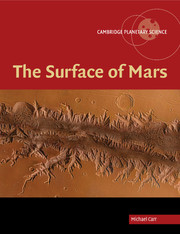3 - Volcanism
Published online by Cambridge University Press: 12 August 2009
Summary
In the late 1960s the Mariner 6 and 7 spacecraft sent back images of Mars that seemed to indicate that it was a dead, cratered planet, much like the Moon. The volcanoes gave us the first indications that this was a false impression. When Mariner 9 approached Mars late in 1971, the planet was engulfed in a global dust storm. The surface in the equatorial regions could barely be seen. There were, however, four dark spots, and in the center of each spot was a complex crater. The craters resembled terrestrial summit calderas, volcanic depressions that form by collapse as a result of withdrawal of magma from below. Most calderas look very different from impact craters because they form by collapse rather than by excavation, and because they are commonly the result of multiple events rather than a single event. The craters were clearly calderas and the dark spots were clearly volcanoes poking up above the surrounding dust storm.
We now know that Mars has had a long and complex history of volcanism, and that the planet is probably still active today. The largest volcanoes and the most extensive lava plains are in and around the region of Tharsis. Volcanism probably started very early in the planet's history. By the end of the Noachian, around 3.8 billion years ago, the Tharsis bulge, a volcanic pile 10 km high and 5000 km across, had been largely built.
- Type
- Chapter
- Information
- The Surface of Mars , pp. 43 - 76Publisher: Cambridge University PressPrint publication year: 2007



